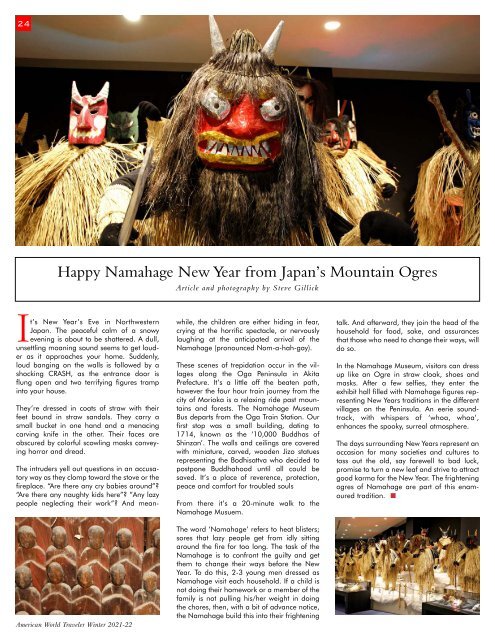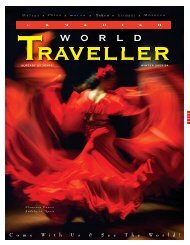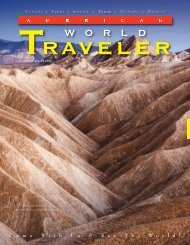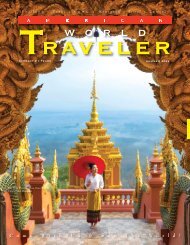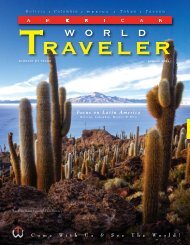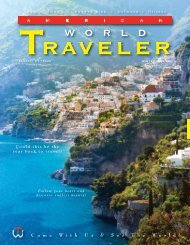American World Traveler Winter 2021-22 Issue
Now in our 20th year of publishing, American World Traveler explores the culture and history of worldwide destinations, sharing the adventure of discovery with our readers and motivating them to make their travel dreams a reality. Published quarterly, AWT helps sophisticated, independent American travelers choose their next destination by offering a lively blend of intelligent, informative articles and tantalizing photographic images from our World’s best destinations, cruises, accommodations and activities to suit every traveler's taste.
Now in our 20th year of publishing, American World Traveler explores the culture and history of worldwide destinations, sharing the adventure of discovery with our readers and motivating them to make their travel dreams a reality. Published quarterly, AWT helps sophisticated, independent American travelers choose their next destination by offering a lively blend of intelligent, informative articles and tantalizing photographic images from our World’s best destinations, cruises, accommodations and activities to suit every traveler's taste.
You also want an ePaper? Increase the reach of your titles
YUMPU automatically turns print PDFs into web optimized ePapers that Google loves.
24<br />
Happy Namahage New Year from Japan’s Mountain Ogres<br />
Article and photography by Steve Gillick<br />
It’s New Year’s Eve in Northwestern<br />
Japan. The peaceful calm of a snowy<br />
evening is about to be shattered. A dull,<br />
unsettling moaning sound seems to get louder<br />
as it approaches your home. Suddenly,<br />
loud banging on the walls is followed by a<br />
shocking CRASH, as the entrance door is<br />
flung open and two terrifying figures tramp<br />
into your house.<br />
They’re dressed in coats of straw with their<br />
feet bound in straw sandals. They carry a<br />
small bucket in one hand and a menacing<br />
carving knife in the other. Their faces are<br />
obscured by colorful scowling masks conveying<br />
horror and dread.<br />
The intruders yell out questions in an accusatory<br />
way as they clomp toward the stove or the<br />
fireplace. “Are there any cry babies around”?<br />
“Are there any naughty kids here”? ”Any lazy<br />
people neglecting their work”? And mean-<br />
<strong>American</strong> <strong>World</strong> <strong>Traveler</strong> <strong>Winter</strong> <strong>2021</strong>-<strong>22</strong><br />
while, the children are either hiding in fear,<br />
crying at the horrific spectacle, or nervously<br />
laughing at the anticipated arrival of the<br />
Namahage (pronounced Nom-a-hah-gay).<br />
These scenes of trepidation occur in the villages<br />
along the Oga Peninsula in Akita<br />
Prefecture. It’s a little off the beaten path,<br />
however the four hour train journey from the<br />
city of Morioka is a relaxing ride past mountains<br />
and forests. The Namahage Museum<br />
Bus departs from the Oga Train Station. Our<br />
first stop was a small building, dating to<br />
1714, known as the ‘10,000 Buddhas of<br />
Shinzan’. The walls and ceilings are covered<br />
with miniature, carved, wooden Jizo statues<br />
representing the Bodhisattva who decided to<br />
postpone Buddhahood until all could be<br />
saved. It’s a place of reverence, protection,<br />
peace and comfort for troubled souls<br />
From there it’s a 20-minute walk to the<br />
Namahage Musuem.<br />
The word ‘Namahage’ refers to heat blisters;<br />
sores that lazy people get from idly sitting<br />
around the fire for too long. The task of the<br />
Namahage is to confront the guilty and get<br />
them to change their ways before the New<br />
Year. To do this, 2-3 young men dressed as<br />
Namahage visit each household. If a child is<br />
not doing their homework or a member of the<br />
family is not pulling his/her weight in doing<br />
the chores, then, with a bit of advance notice,<br />
the Namahage build this into their frightening<br />
talk. And afterward, they join the head of the<br />
household for food, sake, and assurances<br />
that those who need to change their ways, will<br />
do so.<br />
In the Namahage Museum, visitors can dress<br />
up like an Ogre in straw cloak, shoes and<br />
masks. After a few selfies, they enter the<br />
exhibit hall filled with Namahage figures representing<br />
New Years traditions in the different<br />
villages on the Peninsula. An eerie soundtrack,<br />
with whispers of ‘whoa, whoa’,<br />
enhances the spooky, surreal atmosphere.<br />
The days surrounding New Years represent an<br />
occasion for many societies and cultures to<br />
toss out the old, say farewell to bad luck,<br />
promise to turn a new leaf and strive to attract<br />
good karma for the New Year. The frightening<br />
ogres of Namahage are part of this enamoured<br />
tradition.


